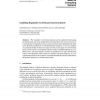Free Online Productivity Tools
i2Speak
i2Symbol
i2OCR
iTex2Img
iWeb2Print
iWeb2Shot
i2Type
iPdf2Split
iPdf2Merge
i2Bopomofo
i2Arabic
i2Style
i2Image
i2PDF
iLatex2Rtf
Sci2ools
MST
2006
2006
Exploiting Regularities for Boolean Function Synthesis
The "regularity" of a Boolean function can be exploited for decreasing its minimization time. It has already been shown that the notion of autosymmetry is a valid measure of regularity, however such a notion has been studied thus far either in the theoretical framework of self-dual Boolean functions, or for the synthesis of a particular family of three-level logic networks. In this paper we show that the degree of autosymmetry of an arbitrary function can be computed implicitly in a very efficient way, and autosymmetry can then be exploited in any logic minimization context. Our algorithms make crucial use of Binary Decision Diagrams. A set of experimental results on the synthesis of standard benchmark functions substantiates the practical relevance of our theoretical results.
Related Content
| Added | 14 Dec 2010 |
| Updated | 14 Dec 2010 |
| Type | Journal |
| Year | 2006 |
| Where | MST |
| Authors | Anna Bernasconi, Valentina Ciriani, Fabrizio Luccio, Linda Pagli |
Comments (0)

